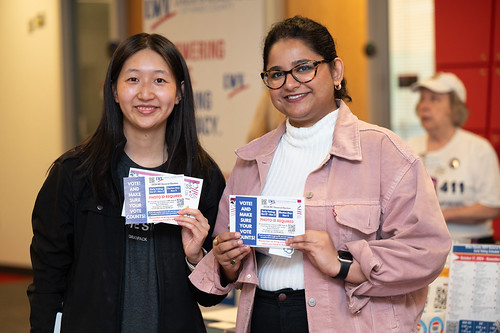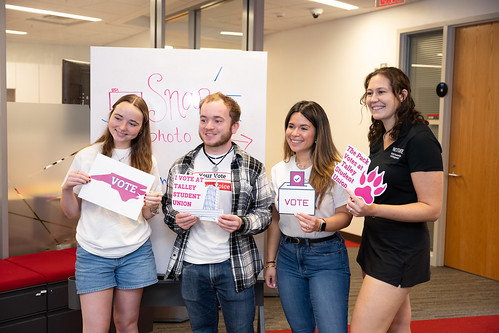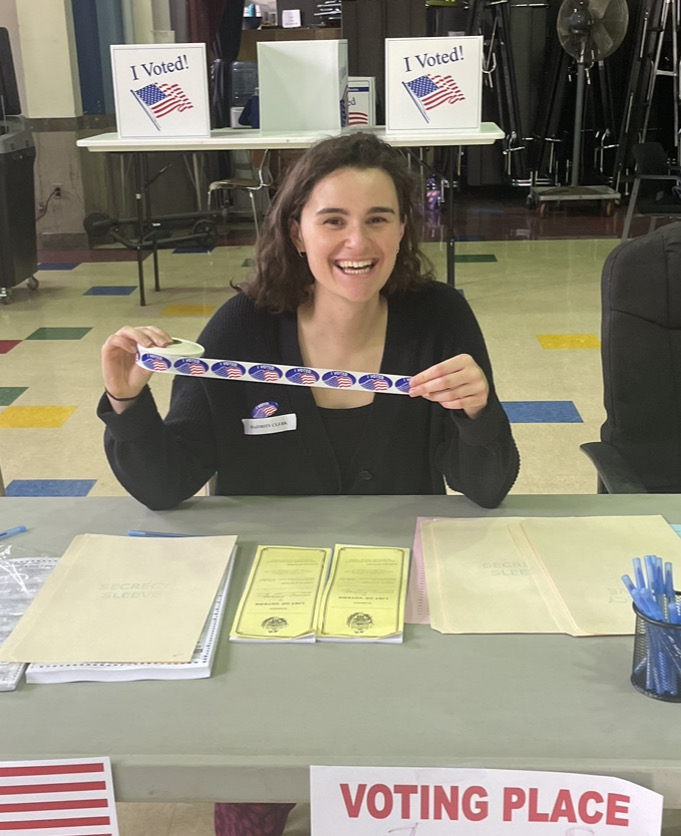Tis the [election] season! Generally, election season refers to the time leading up to Election Day. Depending on the kind of election year — a presidential election year, odd-numbered election years, or a midterm election year — the start of election season can vary.
I like to think about election season as always including these key dates:
- Voter registration deadline;
- Early voting deadlines (in-person and/or by mail); and
- Election Day.
,
Stay Updated
Keep up with the latest election news. Receive emails to your inbox!
,
A telltale sign that it’s election season is an outpouring of canvassers, people who try to persuade you to vote for or against a candidate or issue. Canvassers may go door-to-door with literature to talk to you about certain candidates or issues. In recent years, canvassers have reached out to voters through tactics like phone and textbanking, some using tools like our digital organizing app, League in Action.
Types of Elections
There are different types of elections. One is a general election, often in November and after a primary that happened earlier in the year, where voters will determine the final people that will represent them in federal, state, or local office.
,

,
Before the general election comes a primary election, or primaries. During a primary election, voters choose the candidate they want to see represent a party in the general election. Primary elections vary by state (and aren’t the same as caucuses), so make sure to check your primary election date on VOTE411.org.
Sometimes, states or communities will have special elections: these occur when an official can no longer serve their term. Special elections can occur if someone resigns, dies, or is removed from office.
Election Day
In the United States, general elections for the President of the United States are held on the first Tuesday, following the first Monday of November. In most states, Election Day is not the only day to vote. The final day to vote can vary by state, depending on each state’s rules for early voting.
Get Your Voting Info on VOTE411
Eligibility Requirements
Eligibility requirements vary by state, but to vote in federal, state, or local elections in the United States, you must, at a minimum:
- Be a citizen of the United States (this includes US citizens living abroad, dual citizens, or citizens who were born abroad);
- Be 18 years old on or before Election Day (some states allow 17-year-olds to vote in the primary as long as they’ll be 18 by the general election, and some places allow people as young as 16 years old to vote in local elections);
- Meet your state’s residency requirements (unhoused and housing-insecure voters can vote, even if they do not have a permanent address); and
- Meet your state’s voter registration deadline.
Here’s where it can get tricky: additional voter eligibility requirements can vary depending on where you live. For example, individuals with felony convictions in certain states may or may not be eligible to vote.
,

,
Long story short, voter eligibility requirements can vary by state. Make sure to check out whether you are eligible to vote with VOTE411’s “Voting in My State” interactive tool.
Voter Registration
Alright, so you checked out your state’s voter eligibility requirements, and you can vote in your upcoming election — hooray! The next step is to complete your voter registration. This is pretty much what it sounds like: eligible voters must apply or register to vote in upcoming elections Voter registration applications usually ask for your name, date of birth, address, and about eligibility requirements. In some states, voters may also select their political party while registering.
Most voters can register to vote online, in-person, or by mail: some states even have in-person voter registration on Election Day or during early voting! But like voter eligibility requirements, voter registration looks different state-by-state. Some states don’t have online voter registration, while other states — like my home state of Massachusetts — allow those under the age of 18 to pre-register to vote, so they’ll be added to the voter list when they turn 18.
,
Get involved in your community! Join one of the 700+ state and local Leagues.
,
You can register to vote on VOTE411 and learn more about each state’s voter registration requirements, including Election Day registration where available.
Your Ballot
Picture it: you’re registered, ready to participate in your democracy, and you look at a ballot for the first time. It’s just…a lot. I’m talking alarm bells going off: standardized test-like instructions about filling in the bubbles completely, a bunch of candidate names and races, confusingly worded questions that don’t make any sense, and there’s a front AND a back. You feel like Maverick in Top Gun, like, “Talk to me, Goose!”
Let’s take a step back — no need to stress! Before you mark your ballot with that blue or black pen, read through candidate answers and fill out your personalized ballot at VOTE411. Some states provide sample ballots online, copies of what your real ballot will look like, for voters to preview or practice ahead of time. If you make a mistake, talk to your poll worker or look for guidance from your secretary of state or election office.
,

,
Depending on the election, you may see a variety of things on your ballot:
- Write-in candidates: Candidates’ names are usually pre-printed on the ballot. Sometimes, there is space to write in a candidate, which means that the voter can write in a different option than those printed on the ballot.
- Uncontested races are those in which there is only one candidate for each seat or office, as opposed to contested races, in which there is more than one candidate for each seat or office.
- Ballot measures, also known as ballot initiatives, referendums, or constitutional amendments: These are statewide or local questions, issues, amendments, or topics voters will decide on. Reproductive rights, fair maps, and minimum wage are just a few examples of ballot measure issues.
Once you’ve made your choices, now is time to cast your ballot: this is the actual act of voting! If you vote in person on paper, you will cast your ballot by inserting it into the voting machine, or tabulator. If you vote in person on an electronic voting machine, you will often review your final choices one last time on a summary screen and then hit submit, or vote.
Ways to Vote
Early Voting
While many people vote on Election Day, some states allow voters to vote early, which means that voters cast their ballot before Election Day. States will establish an early voting period for voters, typically starting a few weeks ahead of Election Day.
,
,
Voters can vote early in person or by mail.
Absentee Voting and Vote-by-Mail
These terms are thrown around so much these days, it’s easy to mix them up — but, depending on who you ask, they aren’t always interchangeable.
Think of the word “absent”: voters utilizing absentee voting systems are unable to vote at their polling place. While most states have an absentee voting system, it’s not uniform across the country. Some states allow no-excuse absentee voting, meaning anyone can request an absentee ballot without explanation. Other states require that voters provide a valid reason for voting absentee. Examples can include illness, being a student studying outside of your permanent residence, or plans to be out of town on Election Day.
Typically, absentee voting is done by mail, which is why some states will refer to it as vote-by-mail or mail-in voting. Why the different terms? Well, it really comes down to the preferences of each state and how they administer their elections.
,

,
Vote-by-mail is exactly what it sounds like: a voter receives their ballot in the mail, fills it out, and mails it back to their election office! All states have some sort of mail-in voting system, with several allowing all of their elections to be conducted by mail.
Drop Boxes
Now, imagine you request a mail-in ballot; you go to VOTE411 to review candidate answers and fill it out — but forget to mail it in. Don’t sweat it, you may be able to utilize ballot drop boxes. Think of ballot drop boxes like a library book return: they're collection boxes where voters can safely submit, or “drop off” their ballot, and election officials will collect it. Ballot drop boxes are always clearly labeled!
Despite claims that voting by mail and drop boxes facilitates voter fraud, these methods are safe and trustworthy ways to vote. Research from MIT’s Election Lab found that voting by mail “increases turnout modestly in midterm and presidential elections” and “increases turnout more in primaries, local elections, and special elections.”
But Mary, I forgot to mail my ballot and we don’t have drop boxes in my community! Now what?!?!? Reader, it’s okay! Rules will differ state by state, which is why you should check out your state’s mail-in voting information on VOTE411.
,
Support our work to empower voters!
,
Some states will allow you to…
- Fill out your absentee ballot and hand it in at your polling place or election office! Whew!
- Surrender your mail-in ballot and vote in person. This means that you bring your mail-in ballot to your polling place and exchange it for an in-person ballot. Poll workers will void the mail-in ballot or destroy it and may require you to sign something saying you haven’t already voted. Depending on state law, you may use a regular ballot (just like all the other voters that showed up in person), or you may vote a provisional ballot. So long, my mail-in ballot!
Provisional Ballot
What’s a provisional ballot, you say? These ballots allow voters to vote even if they encounter an issue, like forgetting to send in their mail-in ballot, voting in the wrong precinct, not having the required photo ID, or having the wrong address listed on their registration. If you vote with a provisional ballot, make sure to ask the poll worker if you need to take any additional steps to ensure your ballot is counted. If they say yes, make sure you follow up!
Polling Places & Voting Centers
Let’s say you make your voting plan and want to vote in person: your polling place is where you’ll cast your ballot. Depending on your address, you’ll be assigned an official polling place. In some states, you may vote at more than one location; in others, you must be at one specific location. That’s why it’s important to update your voter registration status when you move and use a resource like VOTE411 to help you find your current polling place (oh, and did I mention it’ll help you find early voting locations and drop boxes too?)!
Most polling places are in buildings with other purposes, like schools, churches, or community centers. For me, my polling place is a school right across the street from my apartment.
,

The author volunteering as a poll worker
,
Because states and local officials administer elections, some jurisdictions may decide to use vote centers. Vote centers are alternatives to precinct-based polling places “which allow voters to cast their ballot anywhere in the county where they are eligible.”
“Election Day,” Starring…
Poll Workers
When you go to your polling place on Election Day, there will be people there who check you in, give you your ballot, and give you your “I Voted!” sticker. These are poll workers. Poll workers, also known as election workers, can have a variety of responsibilities, from setting up the voting equipment and distributing ballots to greeting voters and providing any assistance. But ultimately, their responsibility is to make sure eligible voters can cast their ballots fairly and freely and that our elections run smoothly.
I had the opportunity to serve as a poll worker in my local municipal primary a few years ago, and I cannot recommend the experience enough! While it was a long day, I served my community, met incredible people, and used my paycheck to buy Kacey Musgrave tickets — so everybody won!
,
,
Being a poll worker is a great way to empower your community.
Poll Watchers
Apart from other voters and poll workers, you may see some poll watchers, or election observers, at your polling place. Poll watchers are not poll workers but individuals who “observe and monitor the election” to make sure that rules are followed. Poll watchers can be people from organizations like the League or representatives from campaigns or political parties.
Well, you made it! Refer to this election glossary before casting your ballot. And don’t forget, an informed voter is a powerful one. Before you head to the polls, vote early, or fill our your mail in ballot, make to check out VOTE411 to make your voting plan or find your state’s specific voting rules.